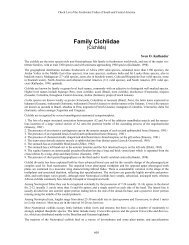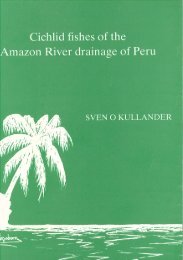Open Access PDF - Sven Kullander
Open Access PDF - Sven Kullander
Open Access PDF - Sven Kullander
Create successful ePaper yourself
Turn your PDF publications into a flip-book with our unique Google optimized e-Paper software.
392<br />
60<br />
61<br />
C. piquiti<br />
C. intermedia<br />
C. ocellaris<br />
C. nigromaculata<br />
C. monoculus<br />
C. kelberi<br />
C. pleiozona<br />
C. orinocensis<br />
C. mirianae<br />
C. thyrorus<br />
C. jariina<br />
C. pinima<br />
C. vazzoleri<br />
C. temensis<br />
C. melaniae<br />
Fig. 93. Strict consensus tree of 14 most parsimonious<br />
trees of species of Cichla, based on 11 characters (Table<br />
27). Multistate characters unordered, all characters of<br />
equal weight, multistate taxa treated as variable, tree<br />
length = 28, consistency index = 0.6071, retention index<br />
= 0.7755, rescaled consistency index = 0.4708. Numbers<br />
at nodes are bootstrap values (100 replicates) over<br />
50 %.<br />
bound algorithm in PAUP* (Swofford, 2001),<br />
results in a relatively well resolved consensus tree<br />
(Fig. 93), despite being based on more taxa than<br />
characters, and with only low bootstrap support<br />
for unresolved groups formed by C. monoculus,<br />
C. kelberi, and C. pleiozona (60 %), and C. temensis,<br />
C. vazzoleri, C. pinima, C. thyrorus, and C. jariina<br />
(61 %). In a majority of the trees C. thyrorus comes<br />
out as sister to remaining species in the latter<br />
clade.<br />
Based on this preliminary analysis, we propose<br />
that Cichla phylogeny is characterized by a major<br />
branching represented by the species with abbreviated<br />
lateral band on one side, and the species<br />
with regular rows of light spots on the other side,<br />
and subsequent diversification in allopatry within<br />
these potential clades. The basal taxa, C. melaniae<br />
(lower Xingu), C. piquiti (Tocantins), and<br />
C. intermedia (parts of the Orinoco drainage) re-<br />
cover the Guiana and Brazilian shields, and the<br />
basal position fits with the position of C. mirianae<br />
(upper Xingu, Tapajós) at the base of the branch<br />
to the species with abbreviated juvenile band.<br />
With one exception, the widespread C. monoculus,<br />
all species of Cichla are associated with the Guianas<br />
and Brazilian shields, and generally with clear<br />
or black waters.<br />
The elongate species with light spots are endemic<br />
to the Guiana shield, except C. pinima which<br />
is mainly collected from the southern bank of the<br />
Amazon, and C. temensis which is reported from<br />
the Madeira and Solimões.<br />
Molecular divergence of C. monoculus + C. orinocensis<br />
vs. C. temensis is suggested in the trees<br />
of Farias et al. (2001, cytochrome b). In López-<br />
Fernandez et al. (2004, 2005), C. intermedia and<br />
C. orinocensis are sister to C. temensis, based on a<br />
morphological analysis and the mitochondrial<br />
ND4 gene, compatible with our conclusion.<br />
Andrade et al. (2001) sequenced the rRNA 16S<br />
gene in Cichla samples identified as C. temensis,<br />
C. monoculus, and what they considered as intermediate<br />
possible hybrids based on external aspects.<br />
Their photographs suggest that their C. temensis,<br />
and two hybrid forms represent C. pinima<br />
(male, female). The photograph of C. monoculus<br />
may be correctly identified. The material list and<br />
tree suggests that C. monoculus (Clade B2), C. kelberi<br />
(Clade B3) and C. vazzoleri may also be included,<br />
and the ‘hybrids’ may just be ontogenetic<br />
stages or females. Although the cluster<br />
analysis (UPGMA) supports two major clusters<br />
(‘C. monoculus’ and ‘C. temensis’ lineages), no<br />
further conclusions are possible without proper<br />
identification of the samples included.<br />
Brinn et al. (2004) identified karyological<br />
evidence of hybridization between C. monoculus<br />
and C. temensis in the Rio Uatumã. Their illustrations<br />
show C. monoculus with aberrant colour<br />
pattern (fig. 1A), a C. temensis (fig. 1B), and two<br />
specimens identified as hybrids from the “juncture<br />
of Lake Balbina with the Uatumã River”, but<br />
which we recognize as C. vazzoleri (fig. 1C, probable<br />
female; fig. 1D, probable male). The Balbina<br />
dam was completed in 1987. We identified C. monoculus,<br />
C. temensis and C. vazzoleri in pre-dam<br />
collections from rapids or close to rapids, dating<br />
back to 1983, and we identify the ‘hybrid’ (C. vazzoleri)<br />
also in the lower Rio Trombetas drainage.<br />
We thus suggest that there must be alternative<br />
interpretations of the karyological data.<br />
<strong>Kullander</strong> & Ferreira: Review of Cichla




